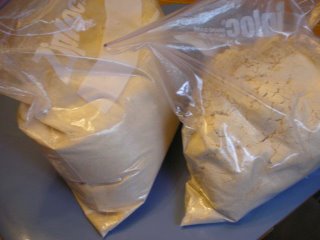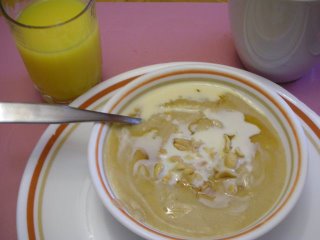Recipe #6: "Tom Brown" porridge
 My recent "Ashanti fowl" recipe took me 3 days to post, so here's a quick and easy breakfast food for recipe #6.
My recent "Ashanti fowl" recipe took me 3 days to post, so here's a quick and easy breakfast food for recipe #6.A friend who just returned from Ghana stopped by recently with 2 bags of toasted cornflour. I've been wanting to make the porridge called "Tom Brown" the past few days, and was happy to have it.
She said she knows I like "aprapransa" (a palm soup/stew dish with the toasted corn flour I'll share another day). I corrected her that it was my husband who really loves it, but every time I make it he complains that it isn't as good as his grandmother's was. She assured me that no matter what I will do, it will NEVER be as good as he remembers hers, so I should "just let go of that burden." Thank you, Connie.
The "Tom Brown" porridge recipe is quite simple. The hardest part is getting the right corn flour. In Ghana they lightly toast the corn before grinding it. For years I tried unsuccessfully to duplicate the process. The corn in Ghana is not sweet corn, it is hard like Indian corn. One recipe said to use ground popcorn, toasted lightly in a dry frying pan. It's much simpler to check with an African market that specializes in West African ingredients and get it from them. This is a favorite student breakfast food I remember fondly from my days teaching at a boarding school in Nungua, along the coast of Ghana.
To make enough for 2 people, one simply brings 1/2 cup of water to a boil in a pan. While it is heating, add 1/2 cup of the flour to 1/2 cup of water in a bowl, and a little salt to taste and mix thoroughly (I use a whisk). When the water in the pan comes to a boil, reduce the heat and slowly stir in the flour/water mixture. It will cook in just a couple of minutes. I ate mine with some honey, evaporated milk (the way I learned to eat it in Ghana), and chopped peanuts on top. If you like a thinner porridge, just add more water.

Labels: corn porridge, porridge, Tom Brown

